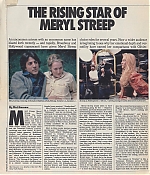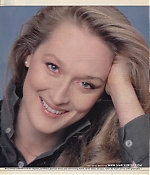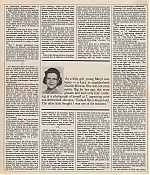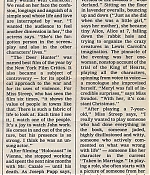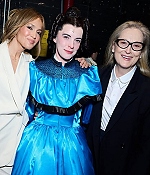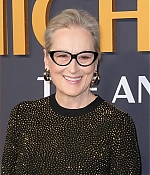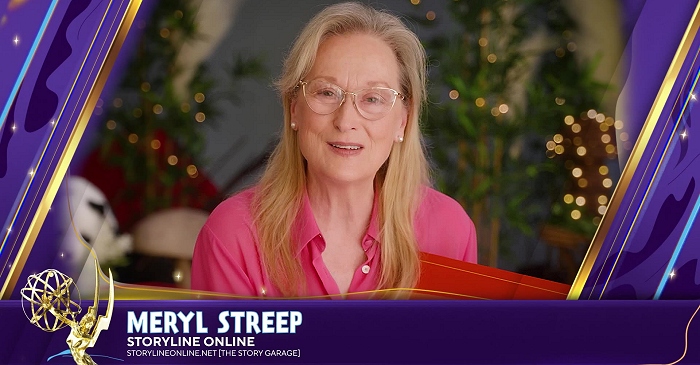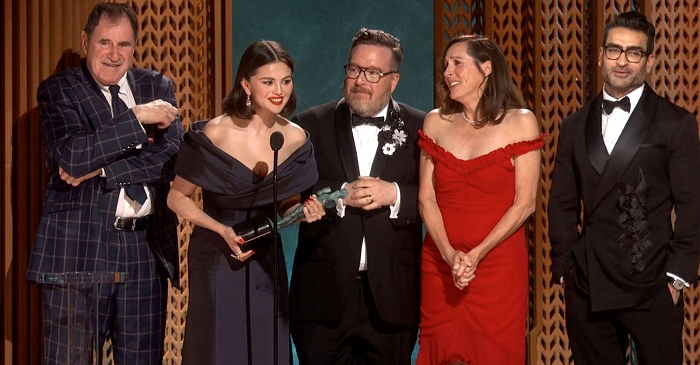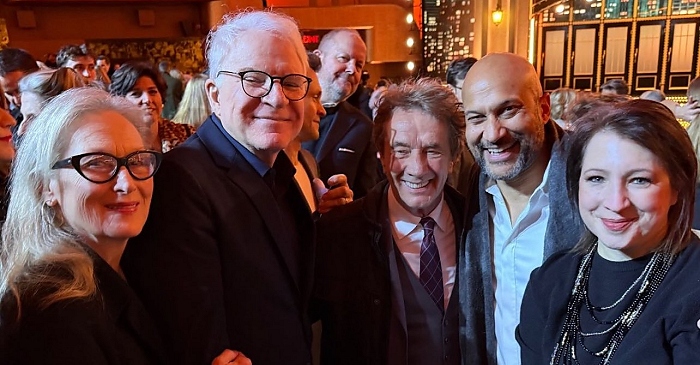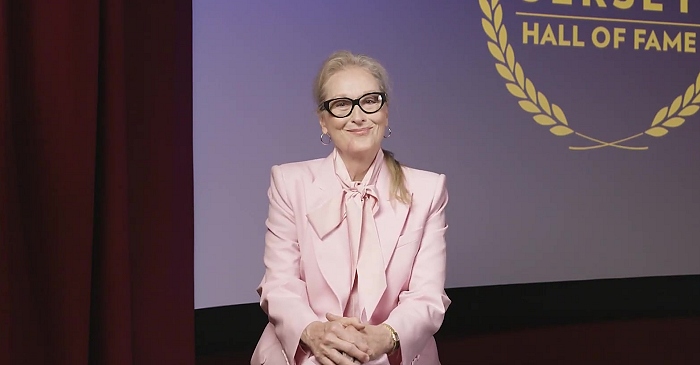|
Simply Streep is your premiere source on Meryl Streep's work on film, television and in the theatre - a career that has won her the praise to be one of the world's greatest working actresses. Created in 1999, we have built an extensive collection to discover Miss Streep's body of work through articles, photos and videos. Enjoy your stay.
|
Celebrating
25 years
of SimplyStreep
|
|
The Rising Star of Meryl Streep
The New York Times Magazine ·
February 04, 1977
· Written by Mel Gussow
|
An uncommon actress with an uncommon name has blazed forth recently – and rapidly. Broadway and Hollywood cognoscenti have given Meryl Streep choice roles for several years. Now a wider audience is beginning to see why her emotional depth and versatility have earned her comparisons with Olivier.
Meryl Streep, Meryl Streep, Meryl Streep. The name may still be unfamiliar to the general public, but soon it should echo from coast to coast, like those classic trains, the Super Chief and the Twentieth Century Limited, rocketing over their tracks. In glass-towered talent agencies, Hollywood studios, and offices of Broadway producers – wherever deals are made and careers launched – people in the know are asking for Streep, more Streep. That’s Streep as in sweep. In her three years in the New York theater, Meryl Streep has swept critics and playgoers off their feet with a stunning diversity of performances – as the fat Southern “baby doll” in Tennessee Williams’ “27 Wagons Full of Cotton,” which won her a Tony nomination; as a tempestuous, high-spirited Kate in “The Taming of the Shrew” in Central Park; as a zany, childlike Alice in a concert version of Elizabeth Swados’ new musical, “Wonderland.”
Miss Streep’s television performance as a Catholic married to a Jew in “Holocaust” won her an Emmy. Her portrayal of a young woman in a Middle American steel town in “The Deer Hunter” has already won her an award as best supporting actress from the National Society of Film Critics. Three major movies are coming out this year: “The Senator,” with Alan Alda, Woody Allen’s “Manhattan,” and “Kramer vs. Kramer,” co-starring Dustin . Hoffman. Currently, she is at Joseph Papp’s Public Theater in Thomas Babe’s new play, “Taken in Marriage.” As Mr. Papp says: “She is as hot as a pistol.” This should be the season of Streep. Miss Streep joins Diane Keaton and Jill Clayburgh as stars for the ’80s – fresh, natural anti-ingenues. These are stage actresses who have become movie stars on their own terms, free of Fredericks of Hollywood, ready to clown as well as to play heroines. In their wake should follow Swoosie Kurtz, Lindsay Crouse, Marybeth Hurt, Jill Eikenberry, Sigourney Weaver and Tovah Feldshuh (their names are as unusual as their talent). Meryl Streep would seem to have everything going for her – elegance, earthiness, patrician beauty and even a self-mocking sense of humor. It all adds up to the singularity that is Streep. She has high cheekbones, long flowing blonde hair, expressive features – looks that lead cinematographer Nestor Almendros to say, “I love to photograph her. It’s like photographing a Brancusi.”
Characteristically, she can deflate praise nicely. Told that she has a classic profile, she laughs and says, “I just have a hooked nose.” Robert Brustein, artistic director of the Yaie Repertory Theater and dean of the Yale School of Drama, where Miss Streep studied, compares her to Carole Lombard, but adds, “She’s more than that. She could do virtually anything – wonderfully.1′ Arvin Brown, head of the Long Wharf Theater in New Haven, is often in artistic disagreement with Mr, Brustein, but on Meryl Streep they see eye to eye. Having directed her on Broadway, Mr. Brown says: “I think she’s the major actress of her generation. Her external transformations trigger a much more profound inner change. What could seem at her age (29) to be tremendous versatility – God knows, that’s prized – is more than that. She can play that dolt, that almost bovine presence in ’27 Wagons,’ or a woman of sensibility. Just as with Olivier, there’s nothing she can’t do.” “She’s phenomenal,” says Robert Benton, who directed her in “Kramer vs. Kramer.” In this movie, scheduled for Christmas release, Miss Streep plays Dustin Hoffman’s wife, who early in the picture abandons him and their small son. Later, she returns, seeking custody of the child. Avery Gorman’s novel, on which the movie is based, is sympathetic to the father at the expense of the mother. Mr. Benton’s script is more balanced, but he was unhappy with his writing of the court scene, in which the wife finally gets to state her case. He suggested that Miss Streep might try to write it in her own words. “It was absolutely brilliant,” Mr. Benton recalls. “It appears in the movie, word for word, exactly as she wrote it. It’s some of the best writing in the picture – and it’s hers. My wife said, ‘You should rewrite the ending, and let her have the child.’ ”
“The woman in ‘Kramer” is like a Tennessee Williams person,” Miss Streep says, “one who bruises. How can I play her? I’m not a mother. I was not married at the time. I don’t live on the Upper East Side. But people outside of an experience sometimes have a greater insight than those living it. I went up and hung around an East Sid’e family playground in Central Park.” She listened to the mothers, the traffic noises, the birds. “It all gave me a quiet, atmospheric understanding of what goes on.” Robert De Niro, who co-stars with her in “The Deer Hunter,” is also enthusiastic: “Women who are very beautiful often let their beauty inhibit them. They tend to have no character. When a woman is beautiful and has an extra edge – like Meryl – it’s nice. She has an excellent sense of timing and she’s funny. She has a sense of herself as being funny.” As a little girl, young Meryl was gloriously bossy, aggressive, a show-off – a Lucy to neighborhood Charlie Browns. She was not even pretty. Big for her age, she wore glasses and had curly hair. From a photo album, she takes apicture of herself at 7, looking prim and determined, and says, “I looked like a 40-year-old. The other kids thought I was one of the teachers.” When she was 12, she sang in a school concert, a solo, “Holy Night” in French, and it stunned her family as well as her classmates. She had a beautiful voice – a 12-year-old coloratura Her parents took her to New York where she sang for Estelle Liebling, whose most famous voice student was Beverly Sills. Miss Streep and Miss Sills took lessons in sequence. “She was at 10:30,” says Miss Streep. “I went at 11:30. I was 12 years old and she was about to make her debut, I thought she was good. I thought I was good, too.” She abandoned the lessons after four years because “I was more interested in boys and in being a cheerleader.”
How could a bossy girl with frizzy hair become a cheerleader? She took off her glasses and threw them away (never to wear them again). At 14, she had taken off her dental braces; at 15 she made up her mind to be beautiful. It was her first acting triumph – or transformation. Almost overnight, she became a cheerleader, swimming champion and „ homecoming queen. She also began acting. In her final three years at Bernards High School, in Bernardsville, N.J., she played the lead in the annual musical. Miss Streep enrolled at Vassar, took her first class in theater and in her sophomore year auditioned for and won the title role in “Miss Julie.” “She was brilliant,” says Clint Atkinson, her first director. Emphasizing her talent for tragedy – “the volcano within her” – he adds that she played Strindberg “with a voluptuousness that was almost shocking in someone of that age.” She quickly became a star at Vassar. One spring vacation, she made her New York theatrical debut with Michael Moriarty at the Cubiculo Theater in “The Playboy of Seville” by Tirso de Molina. On an exchange program, she spent a term at Dartmouth, studying costume design (she is an adept artist), play writing (she wrote funny feminist dramas), and dance, and then returned to graduate from Vassar. For a season, she acted with a small Vermont theater group, the Green Mountain Guild, with her admiring family always in attendance. “We went around to ski resorts and put on Chekhov. You could hear the snoring in the bar and the snowmobiles outside. I decided to go to professional graduate school. The entrance fee at Juilliard was $50, more than I was making a week,” Since Yale was cheaper – $15 – that’s where she applied. For her audition, she did Blanche Dubois and Portia. “I didn’t know what I was doing,” she says, “but they let me in.” She became a legend at Yale, as she had at Vassar. Her most celebrated performance was in production of a new play by two young Yale colleagues, Albert Innaurato and Christopher Durang. The play was “The Idiot’s Karamazov,” a lunatic musical travesty of Russian – and other – literature. The leading role was the translator, Constance Garnett, depicted as a withered octogenarian in a wheelchair. In the show’s earliest performance, Constance was played by Mr. Innaurato. Miss Streep replaced him and completely took over the role, wheeling deliriously around a postage stamp-sized stage. “She invented the part,” says Mr. Innaurato, “marvelously transforming her self into that 80-year-old literateuse. She even sang a Barbra Streisand parody – and it was not a betrayal of the work. She pulled it off. She’s a genius.”
After graduating from Yale, she moved to New York. “I thought, Tm 26. I’m starting my career. I better make it next year.’ ” She did. She won a supporting role in “Trelawney of The Wells” at Lincoln Center. Then she tried out for “27 Wagons Full of Cotton.” The character was fat, vulgar and sloppy. She was thin and svelte. Before the audition, she ducked into the ladies’ room and stuffed 27 wagons full of tissue paper into her dress. Assuming “an outrageously overdone” Southern accent, she read for Arvin Brown, and was hired. To play the part, she went to a prosthetics shop and outfitted herself with padding. Her performance was acclaimed by the critics. In her first season in New York, she did four plays, and was an immediate success. She never had to go to an open audition, do television voice-overs, or face any of the usual struggles of a beginning actress. She did not even have to play ingenues. That summer, she joined the New York Shakespeare Festival, playing the French princess in “Henry V” and the moralistic novice in “Measure for Measure.” Co-starred in “Measure” as the malevolent Angelo was John Cazale, best known as Fredo, the cowardly son of “The Godfather” and as Al Pacino’s sidekick in “Dog Day Afternoon.” The two fell in love and lived together for two years, during which Mr. Cazale learned that he had cancer. It was a time of great heartbreak – the first emotional setback in her life. All through his illness, she apparently never lost her equilibrium. Only once did she drop her customary optimism. When Mr. Cazale went into the hospital for the last time, she told her brother, “John’s not doing so good.”
In spite of Mr. Cazale’s illness, the two of them acted in “The Deer Hunter.” This was her first major screen role (she had appeared fleetingly in “Julia”). In this film, Miss Streep imbues a rather ordinary woman with character, We read on her face the confusion, longings and anguish of a simple soul whose life and love are interrupted by war. “I wanted the audience to feel another dimension in her,” the actress says’. “She’s the forgotten person in the screenplay and also in the other . characters’lives.” “The Deer Hunter” won an Oscar for Best Picture at the 51st Academy Awards in April and was named best film of the year by the New York Film Critics. It also became a subject of controversy – for its apolitical approach to the war and for its uses of violence. Miss Streep has seen the film six times: “It shows the value of people in towns like that. There is such a fabric of life to look at. Each time I see it, I watch one of the people. It’s a joy to watch John work. He comes in and out of the picture, but his presence is so strong. I think he was an unsung actor.” After filming “Holocaust” in Vienna, she stopped working and spent the next nine months with Mr. Cazale – until his death. Miss Streep acted in her next film, “The Senator,” “on automatic pilot – it seems as if I did it in another life.” Today Miss Streep talks readily about Mr. Cazale as an actor, but when she is asked about their personal relationship she becomes shy and draws the curtain. Asked if she ever “used” herself to play a character, she says, “I never met myself in any play I ever read. I would recognize myself easily! By my outlook on things – somebody always trying to give her best shot – and sometimes not making it. A sense of humor about herself. A short attention span. A lot of great ideas. Very lazy.” When it is suggested that she seems extraordinarily well adjusted, she adds, “I really reject the idea that you have to be neurotic to be in the theater. You have to live and keep your eyes open. A lot of terrible things will come your way; you don’t have to seek them. And some good things, too.”
In September she married Don Gummer, a sculptor; he builds huge wood wall pieces, architectural frameworks. They were introduced about a year ago by her brother Harry and they live in a loft in Soho. He has a study crammed with books, papers and scripts, with her Emmy sitting on a cluttered cabinet. The Gurnmers lead a quiet, private life, often visiting art galleries and museums. Their friends include artists and actors such as Marybeth Hurt and Joe Grifasi, an acting buddy from Yale and her partner in the living-room comedy team of Streep and Grifasi. Among her friends and family, she has a reputation for being a remarkable mimic. She is an expert at foreign accents, and does a devilish impersonation of Andrei Serban directing her in “The Cherry Orchard” at Lincoln Center, encouraging her “Lucille Ball tendencies” by telling her to take pratfalls. Transforming herself into a Rumanian, she instructs Streep: “Falling down verrry verrry funny.”
In Meryl Streep, there’s a world of theater, and she would like to do everything-stage tragedy to film comedy, For one thing, she is eager to do more Shakespeare- Cleopatra, Lady Macbeth, Rosalind, Portia. “I never used to have a list like that,” she confesses. She would also like to do more musicals, beginning with a full version ol “Wonderland”. When she heard that they were casting the musical “Evita”. “I put out my feelers.” She is fascinated by the figure of Eva Peron. “If they hired me,” she says, “all my family would come, And my husband has five.Brothers. They would sell out the ftfat tfcree weeks of the show.” Her long-range theatrical dream is to start a traveling troupe of actors who would perform Shakespeare in repertory across America. In her company she would like such friends as Al Pacino, Dustin Hoffman, -Robert De Niro, Raul Julia, Rosemary Harris and Marybeth Hurt, “An actor would do Hamlet one night and Polonius the next. I could do Gertrude and Ophelia. I talked to. Al and he thought it was a great idea. And we could film it. Joe Papp’s ready. Maybe when we’re all 55, we’ll take a measly year off. and not worry about what the other’ person is doing behind one’s back; It would be so wonderful to look back 20 years from now and say, ‘I went out with that troupe 1980. It would be like saying, ‘I was with the Group Theater’ or,’I was with Ellis and Rosemary at the A.P.A,’ or, ‘I was on tour with Katherine Cornell.”
On the brink of major success, Miss Streep realizes that she needs a lawyer and an accountant, but otherwise has no desire’to change her modest lifestyle. She still wears a favorite Hawaiian fireman’s jacket that she has had since college, she buys her dungarees in Greenwich Village, and she is unaffected in her manner. Asked if things had changed for her, she clownishly brays, “Naaaaah!” Then she admits, “But now I’ve turned down some jobs. That makes me . nervous. I usually take everything offered. Now I’m getting… discerning.”

